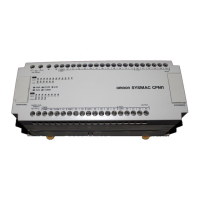506
Glossary
rung See instruction line.
scan The process used to execute a ladder-diagram program. The program is exam-
ined sequentially from start to finish and each instruction is executed in turn
based on execution conditions.
scan time See cycle time.
scheduled interrupt An interrupt that is automatically generated by the system at a specific time or
program location specified by the operator. Scheduled interrupts result in the ex-
ecution of specific subroutines that can be used for instructions that must be ex-
ecuted repeatedly at a specified interval of time.
SCP See subtract count input.
seal See self-maintaining bit.
self diagnosis A process whereby the system checks its own operation and generates a warn-
ing or error if an abnormality is discovered.
self-maintaining bit A bit that is programmed to maintain either an OFF or ON status until set or reset
by specified conditions.
series A wiring method in which Units are wired consecutively in a string.
servicing The process whereby the PC checks a connector or Unit to see if special pro-
cessing is required.
set The process of turning a bit or signal ON.
set value The value from which a decrementing counter starts counting down or to which
an incrementing counter counts up (i.e., the maximum count), or the time from
which or for which a timer starts timing. Set value is abbreviated SV.
shift input signal An input signal whose OFF to ON transition causes data to be shifted one bit.
shift register One or more words in which data is shifted a specified number of units to the
right or left in bit, digit, or word units. In a rotate register, data shifted out one end
is shifted back into the other end. In other shift registers, new data (either spec-
ified data, zero(s) or one(s)) is shifted into one end and the data shifted out at
the other end is lost.
signed binary A binary value that is stored in memory along with a bit that indicates whether
the value is positive or negative.
software error An error that originates in a software program.
software protect A means of protecting data from being changed that uses software as opposed
to a physical switch or other hardware setting.
source (word) The location from which data is taken for use in an instruction, as opposed to the
location to which the result of an instruction is to be written. The latter is called
the destination.
special instruction An instruction input with a function code that handles data processing operations
within ladder diagrams, as opposed to a basic instruction, which makes up the
fundamental portion of a ladder diagram.
SR area A memory area containing flags and other bits/words with specific functions.
SSS See SYSMAC Support Software.

